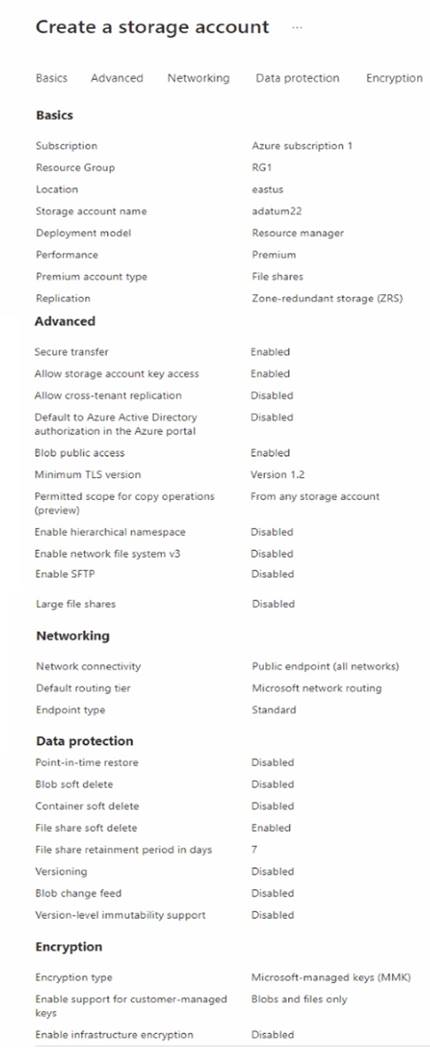HOTSPOT - (Topic 5)
You have an Azure subscription that has offices in the East US and West US Azure regions.
You plan to create the storage account shown in the following exhibit.

Use the drop-down menus to select the answer choice that completes each statement based on the information presented in the graphic. NOTE: Each correct selection is worth one point.
NOTE: Each correct selection is worth one point.
Solution:
The default routing tier setting determines how network traffic is routed from the internet to the storage account. By default, the Microsoft global network routing option is selected, which means that traffic is routed over the Microsoft global network for the bulk of its path, maximizing network performance and reliability. However, this option also incurs network charges for data transfer between different Azure regions. The internet routing option, on the other hand, minimizes the traversal of traffic over the Microsoft global network, handing it off to the transit ISP at the earliest opportunity. This option lowers networking costs, but may compromise network performance and reliability. Therefore, to minimize the network costs of accessing adatum22, which is located in the East US region, from the West US region, you should modify the default routing tier setting to use internet routing instead of Microsoft global network routing. For more information, see Network routing preference for Azure Storage.
Box2 = Encryption Type
https://learn.microsoft.com/en-us/azure/storage/common/infrastructure-encryption- enable?tabs=portal
Does this meet the goal?
Correct Answer:
A
- (Topic 5)
You have an Azure subscription that has the public IP addresses shown in the following table.
You plan to deploy an instance of Azure Firewall Premium named FW1. Which IP addresses can you use?
Correct Answer:
B
https://learn.microsoft.com/en-us/azure/virtual-network/ip-services/public-ip-addresses#at- a-glance
Azure Firewall
- Dynamic IPv4: No
- Static IPv4: Yes
-  Dynamic IPv6: No
Dynamic IPv6: No
- Static IPv6: No
https://learn.microsoft.com/en-us/azure/virtual-network/ip-services/configure-public-ip- firewall
Azure Firewall is a cloud-based network security service that protects your Azure Virtual Network resources. Azure Firewall requires at least one public static IP address to be configured. This IP or set of IPs are used as the external connection point to the firewall. Azure Firewall supports standard SKU public IP addresses. Basic SKU public IP address and public IP prefixes aren't supported.
- (Exam Topic 6)
You deploy an Azure Kubernetes Service (AKS) cluster named Cluster1 that uses the IP addresses shown in the following table.
You need to provide internet users with access to the applications that run in Cluster1. Which IP address should you include in the DNS record for Ousted?
Correct Answer:
B
When any internet user will try to access the cluster which is behind a load balancer, traffic will first hit to load balancer front end IP. So in the DNS configuration you have to provide the IP address of the load balancer.
Reference:
https://stackoverflow.com/questions/43660490/giving-a-dns-name-to-azure-load-balancer
- (Exam Topic 5)
You have an Azure web app named App1. App1 has the deployment slots shown in the following table:
In webapp1-test, you test several changes to App1. You back up App1.
You swap webapp1-test for webapp1-prod and discover that App1 is experiencing performance issues. You need to revert to the previous version of App1 as quickly as possible.
What should you do?
Correct Answer:
B
When you swap deployment slots, Azure swaps the Virtual IP addresses of the source and destination slots, thereby swapping the URLs of the slots. We can easily revert the deployment by swapping back.
You can validate app changes in a staging deployment slot before swapping it with the production slot. Deploying an app to a slot first and swapping it into production makes sure that all instances of the slot are warmed up before being swapped into production. This eliminates downtime when you deploy your app. The traffic redirection is seamless, and no requests are dropped because of swap operations. You can automate this entire workflow by configuring auto swap when pre-swap validation isn't needed.
After a swap, the slot with previously staged app now has the previous production app. If the changes swapped into the production slot aren't as you expect, you can perform the same swap immediately to get your "last known good site" back.
Reference:
https://docs.microsoft.com/en-us/azure/app-service/deploy-staging-slots
- (Exam Topic 4)
You have an Azure subscription named Subscription1 that contains the resources shown in the following table.
You plan to configure Azure Backup reports for Vault1.
You are configuring the Diagnostics settings for the AzureBackupReports log.
Which storage accounts and which Log Analytics workspaces can you use for the Azure Backup reports of Vault1? To answer, select the appropriate options in the answer area.
NOTE: Each correct selection is worth one point.
Solution:
Box 1: storage3 only
Vault1 and storage3 are both in West Europe.
Box 2: Analytics1, Analytics2, Analytics3 https://docs.microsoft.com/en-us/azure/backup/backup-create-rs-vault https://docs.microsoft.com/de-de/azure/backup/configure-reports
Does this meet the goal?
Correct Answer:
A

